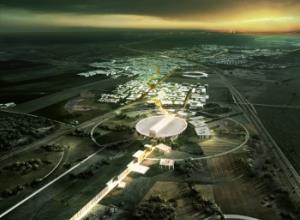European Spallation Source granted patent for neutron detection technology
6 March 2013
The European Spallation Source (ESS) in Lund, Sweden, has been granted its first patent in collaboration with researchers at Linköping University for new technology that will improve the efficiency of its neutron detectors.
The ESS is currently Europe’s largest science project. It is in effect a microscope that uses neutrons instead of light to study the structure and function of materials, ranging from polymers and pharmaceuticals to membranes and molecules.
It overcame a significant technological challenge it was facing for its construction and operational phase by inventing a new technology that will be the basis for neutron detectors used in many of its 22 instruments. With the new boron-10-based detectors, ESS will secure efficient and high-class neutron detection in its instruments, and thus the best experimental opportunities for the science community.

The architectural design for the ESS, announced
Feb 2013.
Photo source: Henning Larsen Architects
Currently, helium-3 is used by scientists for materials research, as a crucial component in neutron instrument detectors. The detectors measure how the neutrons react to a sample being studied. Therefore, the result of an experiment is dependent on efficient detectors. The growing scarcity of helium-3 has affected all current materials research conducted at neutron science facilities worldwide, and has necessitated the development of new technologies for neutron detection.
In order to guarantee efficient neutron detectors at the future ESS facility, and avoid dependence on helium-3, whose production is extremely limited, and consequently very expensive, the Neutron Detector Group at ESS and scientists at the Thin Film Physics Division at Linköping University launched an extensive R&D work aimed at enabling the use of enriched thin films of boron-10 carbide for ESS’ detector systems, instead of using helium-3.
The patent was recently granted by the Swedish Patent and Registration Office, and is the first registered by ESS. The technology will be further developed through prototyping. ESS also has the ambition to set-up a spin-off company with the goal of exploiting additional market demands, including those of neutron scattering facilities, the logistics sector, and other sectors.
“We are very proud about this first patent for the European Spallation Source, which would not have been possible without the thin-films expertise at Linköping University”, says Colin Carlile, CEO of ESS.
“It allows us not only to secure the detector supplies needed for ESS, but to spin out the production in the framework of our new innovation activities, satisfy further market demands, and contribute to growth and jobs.”
Professor Jens Birch of Linköping University emphasizes how quickly and efficiently the problem could be solved: “So far our group is the only one worldwide that can produce these coatings in a reliable manner”, he says.
“Detector development is crucial for the future scientific programme of ESS. With our new detector technology, we have solved a large technological challenge, and will also secure ESS’s independence of current scarce helium-3 supplies”, says ESS detector scientist Carina Höglund.
The detector R&D has been performed as a collaboration between Dr. Carina Höglund from ESS, Prof. Jens Birch and Prof. Lars Hultman from the Thin Film Physics Division at Linköping University. Their patent covers the invention of “a method for producing a neutron detector component comprising a Boron Carbide layer for use in neutron detecting device”.
About ESS
The European Spallation Source is the next generation facility for materials research and life sciences.
ESS will be a multidisciplinary research laboratory based on the world’s most powerful neutron source. ESS can be likened to a large microscope, where neutrons are used instead of light to study materials — ranging from polymers and pharmaceuticals to membranes and molecules — to gain knowledge about their structure and function.
ESS will be around 30 times better than existing facilities, opening up new possibilities for researchers in for example health, environment, climate, energy, transport sciences and cultural heritage.
ESS is an intergovernmental research infrastructure project, and it will be built in Lund in southern Scandinavia. Currently 17 European countries are Partners in the ESS project, and will take part in the construction, financing and operation of the ESS. The Partner Countries are: Sweden, Denmark, the Czech Republic, Estonia, France, Germany, Hungary, Iceland, Italy, Latvia, Lithuania, the Netherlands, Norway, Poland, Spain, Switzerland, United Kingdom.
The European Spallation Source ESS AB is a state-owned limited liability company, today owned by the host countries Sweden and Denmark. ESS AB is currently working on finalizing the ESS technical design, planning the future research at ESS, preparing for construction, and planning the future international ESS organisation.
This is done in collaboration with around 60 Partner Laboratories, research institutes, and universities around the world. During 2013, the ongoing Pre-Construction Phase goes over into Construction, and the ground-break is planned for 2014.
The first neutrons will be produced in 2019 and the facility will be fully operational around 2025. ESS is expected to support a user community of at least 5000 European researchers and will have great strategic importance for the development of the European Research Area. Nearby there will be complementary laboratories, such as the synchrotron MAX IV in Lund and XFEL and PETRAIII in Hamburg.
Website: http://europeanspallationsource.se/